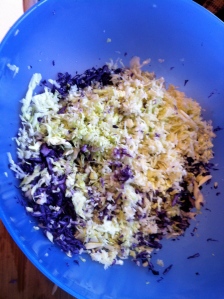Sandor Katz, author of the excellent how-to book, ‘The Art of Fermentation,’ describes fermentation as the flavourful space between fresh and rotten.
Fermenting food not only enhances the flavour, but produces bountiful nutrients and probiotics (aka good bacteria) to aid in digestive health.
Fermentation is also a beautiful process to watch. The food is not stagnant, but dynamic and alive. The bacteria alter the cabbage so that each passing day produces new colours and tastes. You can open your jar and taste the sauekraut every two or three days, and when the taste is to your liking, stick the jar in the fridge to halt the fermentation process, making each batch unique.
Sauerkraut is simple to make and adds a delicious flavour to all sorts of meals, from sausage and other meats to rice and beans, or as a side dise with eggs in the morning.
How to Make Sauerkraut!
Ingredients:
- 1 head of cabbage (about 8 cups). I use half a head of each purple and green (feel free to experiment with other veggies as well, such as carrots, beets, etc)
- 1 tbsp salt (himalayan or celtic sea salt)
1. Wash and drain cabbage well, removing any outer leaves that don’t look so pretty. Save one big outer leaf, as you will use this at the end to help push down and cover the sauerkraut.
2. Increase the surface area by slicing the cabbage as finely as you can. A nice sharp knife does the trick, but you can try grating the cabbage, or use a mandoline or food processor if you have one.
3. Put the sliced cabbage in a large bowl, and add the salt. Use your (clean) hands to thoroughly massage the salt into the cabbage. The cabbage will begin to soften and you will notice juice forming in the bottom of the bowl. This is good (do not discard this juice!). The juice will dissolve the salt, and in turn draw more juice from the cabbage.
4. Massage some more. Keep going until the cabbage is soft and limp, similar in consistency to steamed or stir-fry cabbage. You can taste the cabbage at this point, and it will be noticeably different than the taste and consistency of raw cabbage.
5. Pack the cabbage into a mason (or other) jar, packing it down as you go. Use a wooden spoon or a folded cabbage leaf to press down the cabbage to release any air pockets. Pack it as tightly as you can, and add brine if necessary so that the cabbage is fully submerged. Then place the folded cabbage leaf on top to cover the kraut.
6. Store container at room temperature for three to seven days. You may need to open the lid daily to release the pressure from the gas, and have a taste. The kraut tends to get stronger in flavour the longer it sits at room temp. Once the taste is to your liking, stick it in the fridge and store until you use it all up (which for me isn’t very long!).
Until next time,
T.









